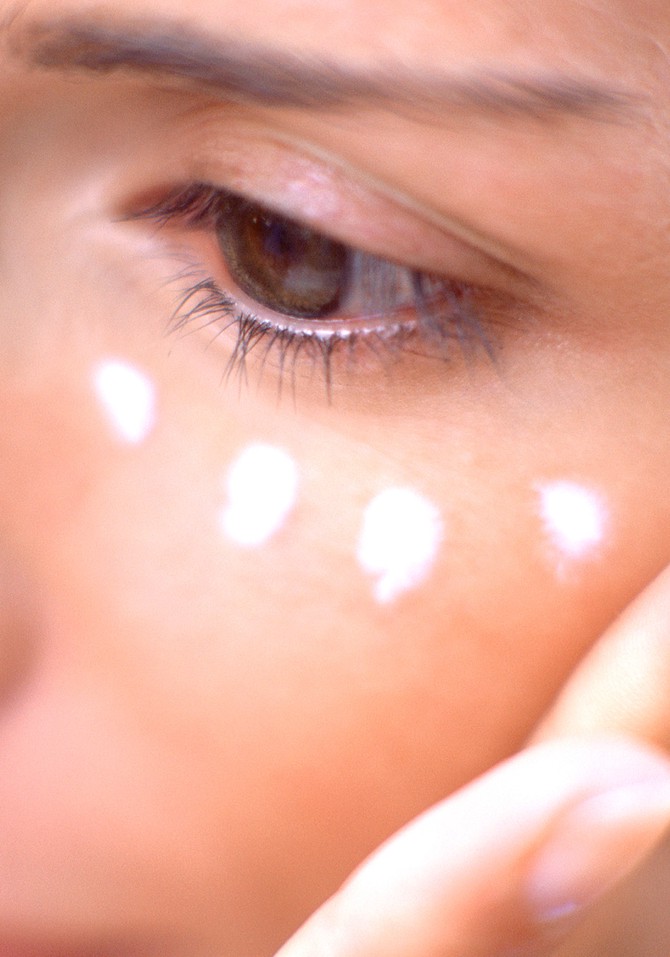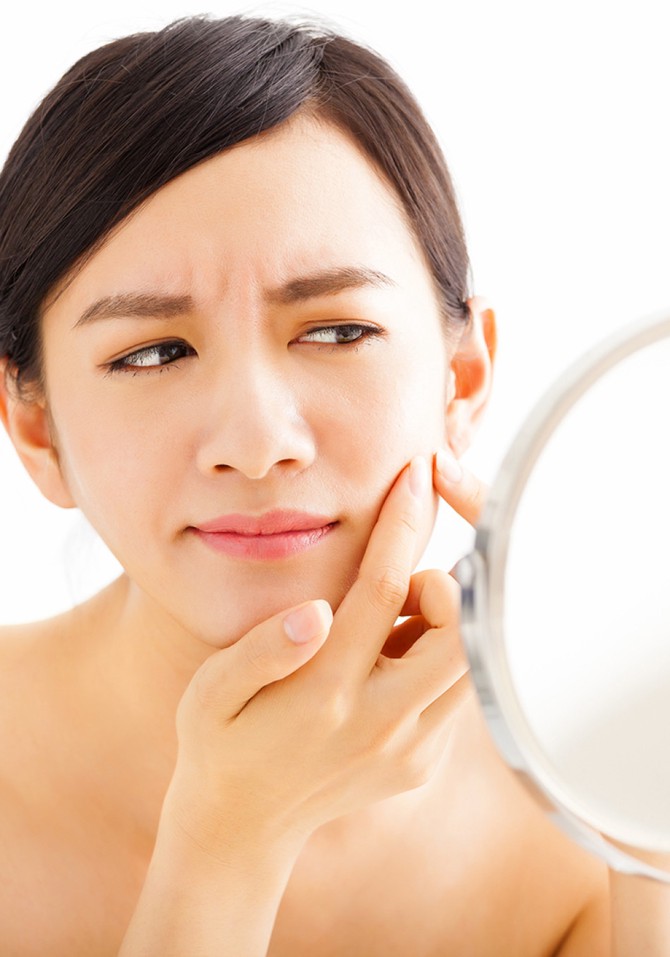The Cure for Puffy Eyes (and 5 More Innovations)
Dreaming of a treatment for under-eye bags? A cure for acne? Sit tight: Your wishes may soon be granted with these wave-of-the-future innovations.

Photo: IS_ImageSource/iStock
The Eyes Have It: I wish the puffiness around my eyes would disappear!
Good news if you're tired of hearing "You look tired": Thanks to a happy accident, puffy eyes may one day be a thing of the past.
It all started in ophthalmologists' offices where patients were given eye drops for glaucoma; several doctors began to notice interesting side effects, including reduced inflammation around the eye sockets. "We all have layers of fat that sit right under the eyelid skin," says North Carolina optometrist Jennifer Lyerly. "It helps protect the eye from injury, but as we age, it tends to slip forward, contributing to swelling. The glaucoma drops 'melt away' that orbital fat, so the eye sinks deeper into the socket." As it turns out, one of the medication's ingredients, XAF5, binds to fat cells and causes them to atrophy, eliminating those pads around the eyes.
Researchers are working on an ointment containing XAF5 to be applied directly to the skin of the lower eyelid; with continued use, the ointment decreases puffiness. It could be as long as five years before this nonsurgical option is FDA approved and we see it on the market.
In the meantime: You can reduce puffiness with an eye cream containing firming ingredients like retinol, vitamin C, niacinamide, or caffeine. Try Algenist Elevate Firming & Lifting Contouring Eye Cream ($72; Sephora.com) or Olay Eyes Ultimate Eye Cream ($30; Drugstores).

Photo: Tomwang112/istock
Spot Check: I wish there were a cure for acne.
Until now, the main treatments for dealing with acne have been topical and oral antibiotics (which clear the skin of acne-causing bacteria), retinoids (which prevent dead skin cells from clogging pores), and benzoyl peroxide (an antibacterial ingredient that eliminates acne-causing bacteria). But each has drawbacks: Antibiotics may contribute to antibiotic resistance; retinoids and benzoyl peroxide can cause irritation. As an alternative, the biopharmaceutical company Dermira has developed a gel called DRM01 that has an entirely new attack strategy. What makes it different, and likely more effective, is that it's preventive. One central cause of acne is excessive oil secreted by the sebaceous glands. DRM01 inhibits oil production by targeting an enzyme essential to the creation of the fatty acids that are a key component of sebum, says Eugene Bauer, MD, cofounder and chief medical officer of Dermira. It would be the first topical to stop the condition at the source. If phase 3 testing is successful and the FDA approves DRM01, it could become available in 18 to 24 months.
Also in the works: Using a technology similar to laser hair removal, researchers have begun experimenting with a laser that destroys oil glands without affecting the attached hair follicles—which could ultimately mean a cure for acne, says R. Rox Anderson, MD, professor of dermatology at Harvard Medical School.
In the meantime: Research suggests that dairy products, particularly skim milk, and refined carbs may worsen acne, so reducing your intake of them may give you a clearer complexion.

Photo: Joshua Pestka
Second Skin: I wish I had a mask to hide my wrinkles (and help my sensitive skin)!
You may have heard the big news a few months back about a technology that allows you to paint on an invisible polymer (a kind of silicone) that provides external support to lift and tighten the skin. Researchers have been testing the film on the eye area, but that's only the first of its many potential applications, says Anderson, one of the creators of the material. The film could be used wherever the skin has lost elasticity or thickness—under the arms, on the thighs, even on stretch marks. And it could be a boon to those suffering from conditions like eczema: The polymer can be fine-tuned to create a thin layer that could remain on the skin for days, providing a barrier that would prevent inflammation and dryness. While developers plan to submit the polymer for FDA approval, they aren't sure when it might become available to the public.
In the meantime: Try Roloxin Lift ($45 for five; Dermarche.com), a facial treatment containing silica particles that adhere to the skin for up to 24 hours to tighten and smooth fine lines.

Photo: PeopleImages/istock
Copy That: I wish there were skincare made especially for me!
For the past 25 years, the cosmetics giant L'Oréal has tested its products on skin produced from human donor cells to avoid animal testing. But last year L'Oréal went a step further, partnering with the 3-D bioprinting company Organovo, creator of such science fiction–like innovations as 3-D printed human organ tissue, to develop a process for producing 3-D bioprinted skin tissue. Here's how it works: The bioprinted tissue starts as an inky liquid made of donor skin cells and nutrient-rich ingredients that keep the cells alive, says Guive Balooch, global vice president of L'Oréal's Technology Incubator. Using a standard 3-D printer, the skin is printed layer by layer into small, circular reservoirs before it's placed inside an incubator to develop for a few weeks.
The speed and precision of this technology allows for more accurate testing of products' safety and efficacy. Future developments could also lead to the production of skin samples with different levels of pigmentation and other variations like texture, resulting in a range of product formulas so diverse, you could practically get a custom fit. Outside the beauty industry, the technology has the potential to transform the fields of plastic surgery and wound care.
In the meantime: Kiehl's has recently introduced Apothecary Preparations (Kiehls.com for locations), a concentrate customized at the skincare counter to address individual complexion concerns.

Photo: Georgijevic/istock
There's An App for That: The Future is Here
Apps give us the technology to monitor and take better care of our bodies, including our largest organ, the skin, says cosmetic chemist Yulia Park, PhD, senior research scientist at the Amway Corporation. These two—one a guide to greener products, the other offering skin analysis and custom product recommendations—are taking skincare to the next level.
Think Dirty
Prompted by a family history of cancer, founder Lily Tse began researching the environmental impact cosmetics can have on health, and Think Dirty was born. Download the app, and next time you're strolling through the beauty aisle and find a mascara or a face wash with unpronounceable ingredients, scan the bar code. You'll get easy-to-understand product information; a rating from 0 to 10, with 10 being the "dirtiest" in terms of toxicity; potential harmful side effects; and any greener alternatives.
Available for free download from the App Store
Oku
The latest from the creators of MySkin.com—a skincare advice website founded by a biophysicist, a plastic surgeon, and two Harvard Business School classmates—is Oku, an iPhone-connected device that sees below the skin's surface and analyzes it using a proprietary light technology. Place Oku on your skin to scan it, answer a few questions about your lifestyle and diet, and you'll get a custom profile along with nutrition suggestions. After seven days of scanning, you'll receive personalized product recommendations based on evaluations of what worked for people with skin similar to yours.
$250 for device (preorder price until October 15) at GetOku.com; app available from the App Store
From the September 2016 issue of O, The Oprah Magazine

